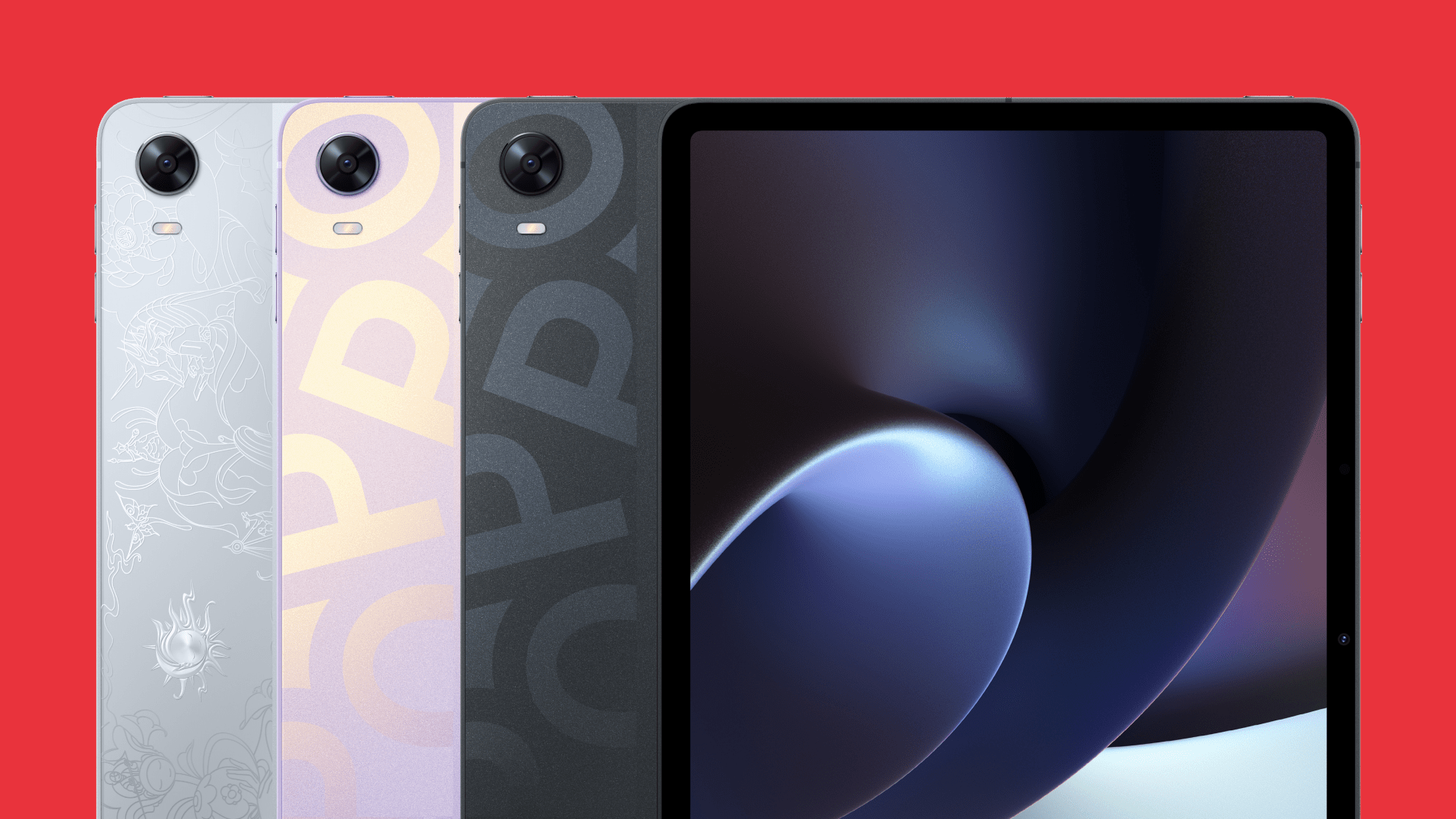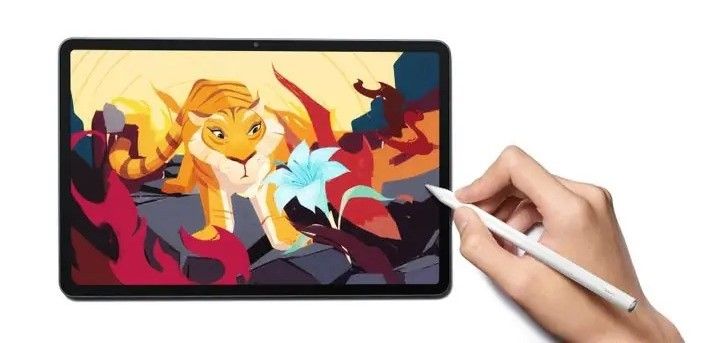Oppo has just announced its very first tablet today. Before you get too excited, the new Oppo Pad is China-only for now, but it has bigger implications given the relationship between Oppo and OnePlus. There's no real proof it will happen in this way, but with OnePlus's phone designs often sharing Oppo hardware, the Oppo Pad opens the door for a long-awaited and recently rumored OnePlus tablet. And, not to get too dramatic, but it could shake up the Android tablet market if it's done right.
The idea of a OnePlus tablet has been brought up repeatedly over the near-decade that the company has been around. Since the OnePlus essentially filled the budget-Android-enthusiast gap left behind by Google when the Nexus program died, and Google gave up on Nexus tablets at around the same time, there's been a low-level background hum of admirers asking for the company to consider a tablet — to date, a request that's gone unfulfilled.
The Oppo Pad and its stylus.
Last year, it seemed that might finally change when OnePlus filed for a "OnePlus Pad" copyright in Europe. ("Pad," that sounds familiar now, doesn't it?) So far, there haven't been many reliable leaks on the subject. Though 91Mobiles believed the tablet would debut in India sometime in the next four months, later rumors indicated that might have been pushed back to the second half of the year, not that there's a lot corroborating either schedule.
This might seem like a tight schedule to deliver a tablet in, given the absence of leaks leading up to it, but OnePlus has been very good at delivering phones in a constrained timeframe. Carl Pei may have left OnePlus, but his team was able to design and deliver the original OnePlus Nord in just six months, according to the company's making-of documentary.
It has a keyboard case, too.
It's a trend that's changed a little in recent years, but OnePlus's flagships often resemble Oppo flagships of the same generation, with leaks for one often being a general indicator of specs we might see in the other. It's an open secret that both brands pull from the same BBK parts bin, and whatever the reason — whether they actively collaborate on the engineering decisions or it's just more cost-effective in terms of scale — OnePlus flagships frequently sound a whole lot like Oppo flagships on paper.
Particulars always differ (especially when it comes to the camera), but the OnePlus 8 Pro shared plenty of its guts with the Oppo Find X2 Pro, the 9 Pro had a lot in common with the X3, the Nord shared specs and design with the Realme X50 Pro and Reno 4 5G, and the OnePlus 7 Pro and Reno 10x were even closer siblings. They haven't been direct copies of each other in a very long time, but these commonalities in specs and design were even more obvious the further back in time you go.
OnePlus seems to be diverging from hardware more from Oppo, but that historic trend could indicate the company's tablet plans. If it doesn't plan on changing a lot from an engineering perspective — say, tweaking the case and maybe the cameras a little, as well as adding its own software — the OnePlus Pad could land hot on the heels of the Oppo Pad in time for that leaked first-half-2022 window. At least, in India.
With OnePlus's focus now on mid-range products in faster-growing markets, I wouldn't be surprised if the company skipped the US again if and when the OnePlus Pad finally materializes. After all, we still don't even have the OnePlus 10 Pro yet, and apart from the cheapest free-on-contract Nord devices carriers can sling, OnePlus has skipped delivering mid-range hardware to the US. Again, we can't be sure this is an apples-to-apples comparison since OnePlus could change the specs (or even if the OnePlus Pad is still coming), but the Oppo Pad's hardware leaves it borderline somewhere between flagship and mid-range:
|
Chipset |
Snapdragon 870 |
|
Display |
11-inch 2560x1600, 120Hz |
|
RAM |
6/8GB |
|
Storage |
128/256GB UFS 3.1 |
|
Cameras |
8 MP f/2 front, 13MP f/2.2 rear |
|
Power |
8,360 mAh battery, 33W wired charging |
|
Connectivity |
2x2 MIMO Wi-Fi 6, BT5.1, BLE |
|
Software |
Color OS 12 (Oppo says Android 11, but Color OS 12 is Android 12) |
|
Dimensions |
507-510g, 252.2 x 163.8 x 6.99mm (7.05 for purple) |
|
Misc |
"Oppo Pencil" stylus w/magnetic wireless charging, smart magnetic keyboard, face unlock (seemingly camera-based) |
The Oppo Pad takes at least a few of its design cues from Apple's massively popular tablets, sharing a similar front-on shape with a curved-edge display, uniform bezels, and a similar edge profile — though Oppo puts its camera in a far better location, I think, given tablets are often used in landscape, with accessories like keyboard cases. Oppo highlights some of its software changes, similar to what it delivered on the Find N, which make multitasking a little easier than on stock Android. There is a small conflict in Oppo's published specs, claiming that the tablet runs ColorOS 12 (which would be Android 12) while also saying it's based on Android 11.
Whether or not the Oppo Pad directly turns into the OnePlus Pad, I think a OnePlus-branded tablet is coming, and it's a good idea for the company. OnePlus has already diversified itself from phones, expanding into awful wearables and surprisingly decent earbuds. Further expanding to capture some of the tablet space in growing markets can only positively affect its ongoing growth. And if OnePlus can execute on it well, it could be good for Android as a whole.
Google and Samsung have both renewed interest in Android tablets after years of languishing at the iPad's feet following the end of the tablet "boom," but our pandemic-fueled Tiger King binging has brought new attention and growth to the category. With Google spending so much time and resources developing big-screen-only features in Android 12L for foldables and tablets, I strongly suspect the company would be willing to lend a hand when it comes to marketing, promotions, and maybe even retail channel partnerships for new Android tablets to make that investment worth it.
OnePlus may have faltered recently when it comes to software, with Oxygen OS 12 landing in an awful, bug-ridden state as the company falls further behind competitor's quality and update commitments — all of this building on prior mistakes, as well — but OnePlus can still turn its situation around, and plenty of fans (like me) would be happy to see that happen. The company wouldn't exactly be starting from scratch on a tablet in either a software or hardware sense, but working on an entirely new product category could help OnePlus shake things up, and they dearly need to be. And with OnePlus's reputation as the Nexus spirit sustained into a Pixel era, a good OnePlus tablet could bring renewed attention to Android tablets as a whole. Paired with OnePlus's recent ability for nearly unhinged market growth, it could also bring competition to a space basically dominated by Samsung.
Hoping that OnePlus can do things right for a change is, frankly, a big leap of faith right now, but if it can, it would be huge for Android. The time is right for Android manufacturers to reconsider their stance on tablets, and Oppo (and, potentially, OnePlus) would be entering the market to take advantage of the opportunity and help shape its direction under the coming tablet renaissance. Oppo has opened the door for a OnePlus tablet, and the timing is perfect.



